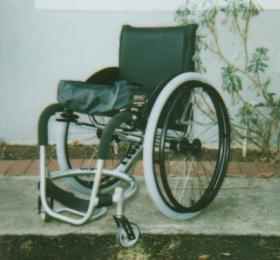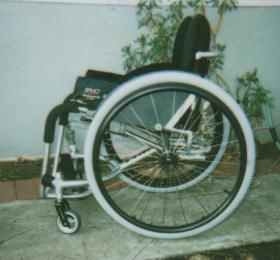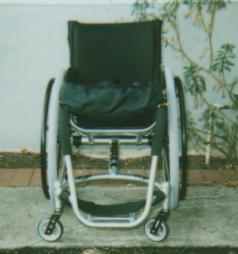

Turn-on-a-dime. Lightening-fast. Featherweight. Stable. Custom-fit. Ultra-cool. These were the features I sought in my new one-off, custom sportschair, and Bob Hall was the man I knew who could help me realize my vision.
Back in the heyday of sportschairs, the 1980’s, I was fortunate to have had one of the first Quickies that rolled out of Motion Designs. Back then, the chair was a lifetime ahead of the E&J Premier in which I learned to push a manual chair (though, a few years earlier, that fifty-pound E&J with its removable armrests was hot stuff, too). Looking back from the twenty-first century, the original Quickies were little more than aluminum boxes on wheels -- then again, as many of us learned, going from a fifty-pound box on wheels to a twenty-five-pound box on wheels was darn close to getting into Heaven. Still, sportschairs weren’t fully formed in their creation.
After several years of striving to use a sports wheelchair instead of relying on a powerchair full time, the Quickie no longer met my needs. I understood that because I wasn’t a super-para-jock, I really needed the best sportschair. I went to a local company, Liberation Concepts, that built custom racing chairs for guys along the lines of Marty Ball, and they help me -- barely fourteen -- build my first custom sportschair. Going from a Quickie to a custom sportschair was like going from combat boots to running shoes -- I once again pushed toward a new level of mobility. The following ten years sat me in the likes of Top End, Rowcycle, and Magic in Motion custom chairs, until my rear finally landed in an Invacare Pro-T in 1995. Play that record again, you say -- why after my love affair with custom chairs did I land in an off-the-shelf Invacare product? Well, the easy answer is, it was free. The more complicated answer is, I was disillusioned that all the small companies I supported had sold-out to the big three manufacturers, so I figured, what the heck, I might as well take an easy ride, too. As it turned out, the Pro-T wasn’t as great as my custom digs, but it was a good, practical set of wheels.
When my Pro-T had more dings than paint on its frame, and even my Cocker Spaniel refused to sit near it in public, I knew it was time for a new sportschair. I reminded myself that I knew my needs better than any engineer building production chairs, so if I wanted the best mobility, I had to once again go custom.
To find a builder who could turn my ideals into metal, I considered custom manufacturers on four continents; however, I kept coming back to Bob Hall, an athlete and builder I followed since the late 1970’s. I provided Hall with sixteen measurements -- ranging from the mundane seat width to the complex rear axle position -- and he requested an additional five specifications, including push-rim and upholstery styles. Of course, being a collaborative effort, we debated several features of the chair, determining what would work best for me. I knew what I wanted in a chair, but Hall really helped me put my ideas into practice, listening and asking all the right questions, proving himself as a master builder who understands how technology and physiology must be equally considered in a chair’s design.
My foremost concern in my chair’s design was to create rearward stability to prevent me from flipping over backward. I have poor balance and frequent muscle spasms, so if a chair is “tippy,” my problems are compounded. I have always used anti-tip “wheelie-bars”; however, though they prevent me from tipping all the way over, merely the unstable rocking motion exacerbates my spasms and poor balance, so I sought to create a chair that was all but bolted to the ground, yet handled like a dream -- a tough order to fill for Hall.
I began with my basic measurements of 15” wide by 16” deep for the seat base, and then gave considerable thought to back height. I needed a tall back height to prevent my shoulders from extending beyond the frame when I spasm rearward; yet, not such a tall back that it would interfere with my push stroke. Whereas most users of my height, 5’10”, would use a 12” tall back, I went with a 15”, which is a fraction below my under arms, resulting in full support, without limiting push stroke motion.
Due to my muscle tone, my knees pull slightly toward my chest. To keep my body in the most natural position it seeks, I use a lot of “squeeze” (seat angle), even on my powerchairs. On my new sportschair, I chose a 19” front seat height, 16” rear seat height, and a 90-degree back angle (measured from the ground plane), which provides a seating position that’s natural to my body’s, allowing my knees to be slightly elevated higher than my waist. Rather than fighting my muscle issues, trying to conform to “normalized” seating, Hall and I chose to address them in the chair’s design.

The next debate was how to taper the seat frame. A narrowed front end makes a chair more maneuverable, allowing one to fit into tighter spaces, and provides a better fit, conforming to your body. There’re three ways to taper a frame -- a seat-base taper, which makes the actual seat base narrow from back to front, conforming to the upper-leg; a seat-to-footrest taper, narrowing the frame’s front “downtubes” from the front edge of the seat to the footrest; and a partial-downtube taper that only extends halfway from the seat’s edge to the footrest, where it then becomes straight (this technique is used to permit a height adjustable footrest). As far as fit, the seat-base taper is the best; however, it has two major drawbacks: Most seat cushions are square -- or rectangular -- so a 15”x15” ROHO isn’t going to work on a seat that tapers in width from 15” at the rear to 12” at the front, and a narrowed seat in the front makes it more difficult to transfer, as the seat is farther from the other transfer surface. For these reasons, I chose the downtube “V” taper, which gives the chair a clean look, as well (I think the partial taper, like on most of Invacare and Permobil’s sportschairs, looks unrefined).

The real challenge was in determining where to mount the rear wheels in relation to the seat frame. Typically, one wants the rear axle position fairly far forward, so that as much as 80% of one’s weight is centered over the rear axle. Although a forward axle location creates a more efficient push stroke, less rolling resistance, and improves handling, it also makes the chair very tippy rearward. Therefore, we had to find a way to mount the rear axle in a position that would maintain stability without sacrificing too much of the chair’s handling. Hall and I tossed measurements back and forth -- starting with my conservative measurement of placing the axle 1” forward of the backrest tube -- and decided that with my seating in proper order, he could mount the rear axle 3” forward of the backrest tube, which would be an acceptable compromise, balancing stability and handling. For the front wheel location (the distance from the rear axle to the front fork stem), we applied my measurement of 17” -- that’s a long wheel base by ultra-high-performance sportschair standards, but I’ve found that a longer wheel base tracks straighter, requiring less effort to keep the chair rolling in a line.
Among the biggest mistakes users make when purchasing a sport wheelchair is ordering too much camber. Sure, the basketball and tennis pros have 15-degrees of camber, making their chairs look like flying saucers, but the fact is, they have to remove the rear wheels to get their chairs through doorways. There’s no doubt that camber increases a chairs side stability; however, it also increases a chairs overall width. Further, the more camber on a wheel, the more flexing and stress it undergoes, all of which consumes your energy and shortens the life of your equipment. In the past, I’ve had between 4 and 8-degrees of camber, and ended up with 4-degrees on this new chair -- and I’m thrilled with the results, as it’s 1.5” narrower than my Pro-T with 6-degrees of camber, but no less stable (1.5” is a huge difference in width, especially when my Pro-T was always an inch too wide for those rotten, narrow bathroom doorways scattered across the Midwest! ).
For the rear wheels, Hall picked up a pair of Sun 24” CR20 36-spoke rims, with black anodized pushrims, high-flange hubs, and big-button quick-release axle, to carry 24x1 3/8” everyday tires. Hall was so perplexed by my insistence on “everyday” tires instead of low-profile, high-psi “Primo” tires, that he asked me, “You mean you want ‘wheelchair’ wheels?” As I explained, Primos are great on court surfaces, but sink into carpeting, trash your pushrims on unpaved surfaces (the low-profile tire doesn’t allow adequate clearance between the pushrim and the ground), and are useless with brakes. Fortunately, Hall got my point, and simply mounted everyday tires on high-performance wheels -- my ideal setup.
Never, ever waste your money on aluminum casters. . . that is, unless you are me. I know, I tell everyone that aluminum casters are an utter waste of money -- usually a $100 upcharge on a new chair -- but I have good reasons for putting 4” aluminum micros on my chair. Firstly, the front width of my chair is only 10”, so it’s a tight instillation for 5” casters (I intended the chair to carry 5” casters, but with it being so narrow, the 4” micros on 4” slotted forks, with a 1” stem spacer, provide much more clearance for my feet, and require less space when turning). Secondly, because my chair was a one-off job, the price was calculated by the exact features chosen, rather than a base price with upcharges -- that is, when one orders an off-the-shelf sportschair, plastic casters are included in the price, then there’s an absurdly high upcharge if one want aluminum casters (truly, one ends up paying around $175 - $200 for a single pair of $65 casters), whereas on a one-off rig, one just pays $65 for the aluminum casters, period. And, what can I say, they look cool. To top off the casters, rather than using a fork stem nut, Hall used a threaded, machined aluminum “dome” that gives the caster housing a seamless, rounded look.
I’m a fan of side guards, the fabric or rigid side panels that keep your clothes, cushion, and hips tucked in. I’ve used both rigid and fabric side guards, removable and bolt-on, and find that the bolt-on rigids, when properly made, are the best. The trick to properly constructing rigid side guards is that they must precisely follow the shape of the wheel -- if they are too tall or short, too shallow or deep, they won’t work effectively. Hall used ¼” plastic -- about three-times as thick as the material used on production chairs -- and through-bolted them in three locations. Again, because my chair’s a one-off, and correct side guard positioning is critical, Hall created the side guards so they follow the wheel’s outline to the fraction -- there’s all but a science to it.
For the brakes, Hall used Quickie’s undermount “scissor” brakes, that flip-out and pull to lock. I’ve had the same brakes on one other chair, and like them better than Invacare’s spring-loaded version (of course, after a week of fighting with Invacare’s brakes, I wised up and removed the darn springs).
The chair’s upholstery is top-of-the line nylon “sail cloth,” and as I requested, the back is thickly padded, with adjustable straps for tension. With the goal of superior rigidity and strength, the backrest doesn’t fold or adjust; however, because the frame is so small with the rear wheels removed, it’s easier to transport than a box-frame chair with a folding back.
As an additional safety measure geared toward my rearward stability issues, I had Hall create a rear anti-tip caster -- note the singular usage of “caster.” Rather than employing two stationary anti-tip casters, as you see on all other chairs, I had Hall take the design from tennis chairs, and create a centered mounted rollerblade caster on a pivoting fork. The idea was that with a single pivoting rear caster, I wouldn’t get as hung up on curbcuts and other obstacles, for the caster could turn and roll in all directions as needed.

Tired of scuffed, chipped, dinged paint, I chose a brushed aluminum finish. The bare aluminum has a slight texture to it that creates a shiny finish that won’t show fingerprints (as an experiment, my brother, the motorcycle guy, used his shop to remove the brushed finish from the anti-tip caster’s tube assembly, and polished it to a true mirror finish -- it looks stunning, but shows every fingerprint, which is why I decided to leave the rest of the chair brushed). Paintless finishes on aluminum and titanium are the best solution for keeping your chair looking good over the long haul.
After twenty years use of sportschairs, I never dreamt one could fit and handle as well as my chair built by Hall. Almost defying logic, the chair is as stable as if mounted on tracks, yet, it turns quicker and rolls better than any chair I’ve owned. As a game, I show the empty chair to my friends, comment on how entirely stable it is, and they always pick it up and flip it right over backward (trust me, it’s light), mocking my claim. Then, I tell them to sit in it and try to jerk it over backwards -- they can’t do it, and like me, are astonished at how such a light, responsive chair can provide so much stability (a friend commented that the chair’s stability allows for a more powerful push stroke because you’re not fighting to balance the chair -- that was my intention, as my push stroke is more gorilla than finesse). Still, when I need to pop a wheelie, it goes right up, balancing perfectly. As Hall said, with my body in the correct position -- and I never knew I could sit up so straight and comfortably -- the chair works in all the ways its supposed to. Of course in one of life’s cruel jokes, now that I finally have an anti-tip caster that truly works, I don’t need it!
(Actually, it took eight weeks to build my chair.)
Indeed, my new one-off sportschair built by Hall turned out as I wished: stable, maneuverable, lightweight, perfectly-tailored, and ultra-cool. In addition, my chair was delivered with one other important feature -- affordability. Out-the-door, my chair came to $2,002, which is a lot less money than one would pay for a production chair with similar features, and remarkable considering that it’s a truly custom, one-off frame.
Overall, my collaboration with Hall proved one point: You can get a better chair, cheaper.